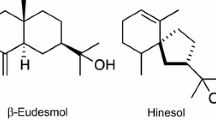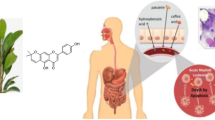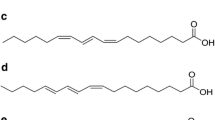Abstract
Costunolide has been reported to be a cytotoxic and chemopreventive agent. This work investigated the mechanism of the antiproliferative effect of costunolide and determined that it induced differentiation of the human leukemia cell line HL-60. Costunolide exhibited a potent antiproliferative activity against HL-60 cells. It was also found to be a potent inducer of differentiation in human leukemia derived HL-60 cells through the examination of differentiation markers, as assessed by the reduction of nitroblue tetrazolium, the increase in esterase activities and phagocytic activity, morphology change and the expression of CD14 and CD66b surface antigens. These results, accompanied by a decline in the expression of c-myc protein, suggest that costunolide induces differentiation of human leukemia cells to granulocytes and monocytes/macrophages lineage.
Similar content being viewed by others
References
Ben-Baruch, N., Reinhold, W. C., Alexandrova, N., Ichinose, I., Blake, M., Trepel, J. B., and Zajac-Kaye, M., c-myc Down-regulation in suramin-treated HL60 cells precedes growth inhibition but does not trigger differentiation.Mol. Pharmacol., 46, 73–78 (1994).
Chen, H. C., Chou, C. K., Lee, S. D., Wang, J. C., and Yeh, S. F., Active compounds fromSaussurea lappa Clarks that suppress hepatitis B virus surface antigen gene expression in human hepatoma cells.Antiviral Res., 27, 99–109 (1995).
Collins, S. J., Ruscetti, F. W., Gallagher, R. E., and Gallo, R. C., Terminal differentiation of human promyelocytic leukemia cells induced by dimethyl sulfoxide and other polar compounds.Proc. Natl. Acad. Sci. USA, 75, 2458–2462 (1978).
Eades-Pemer, A.-M., Thompson, J., van der Putten, H., and Zimmermann, W., Mice transgenic for the human CGM6 gene express its product, the granulocyte marker CD66b, exclusively in granulocytes.Blood, 91, 663–672 (1998).
Filmus, J. and Buick, R.N., Relationship of c-myc expression to differentiation and proliferation of HL-60 cells.Cancer Res., 45, 822–825 (1985).
Iwashita, K., Kobori, M., Yamaki, K., and Tsushida, T., Flavonoids inhibit cell growth and induce apoptosis in B16 melanoma 4A5 cells.Biosci. Biotechnol. Biochem., 64, 1813–1820 (2000).
Koeffler, H. P., Amatruda, T., Ikekawa, N., Kobayashi, Y., and DeLuca, H. F., Induction of macrophage differentiation of human normal and leukemic myeloid stem cells by 1,25-dihydroxyvitamin D3 and its fluorinated analogues.Cancer Res., 44, 5624–5628 (1984).
Koeffler, H. P., Induction of differentiation of human acute myelogenous leukemia cells: therapeutic implications.Blood, 62, 709–721 (1983).
Kondo, K., Watanabe, T., Sasaki, H., Uehara, Y., and Oishi, M., Induction ofin vitro differentiation of mouse embryonal carcinoma (F9) and erythroleukemia (MEL) cells by herbimycin A, an inhibitor of protein phosphorylation.J. Cell Biol., 7, 285–293 (1989).
Lee, M. G., Lee, K. T., Chi, S. G., and Park, J. H., Costunolide induces apoptosis by ROS-mediated mitochondrial permeability transition and cytochrome C release.Biol. Pharm. Bull., 24, 303–306 (2001).
Mori, H., Kawamori, T., Tanaka, T., Qhnishi, M., and Yamahara, J., Chemopreventive effect of costunolide, a constituent of oriental medicine, on azoxymethane-induced intestinal carcinogenesis in rats.Cancer Lett., 83, 171–175 (1994).
Ohnishi, M., Yoshimi, N., Kawamori, T., Ino, N., Hirose, Y., Tanaka, T., Yamahara, J., Miyata, H., and Mori, H., Inhibitory effects of dietary protocatechuic acid and costunolide on 7,12-dimethylbenz[a]anthracene-induced hamster cheek pouch carcinogenesis.Jpn. J. Cancer Res., 88, 111–119 (1997).
Ostrem, V. K., Tanaka, Y., Prahl, J., DeLuca, H. F., and Ikekawa, N., 24- and 26-homo-1,25-dihydroxyvitamin D3: preferential activity in inducing differentiation of human leukemia cells HL-60in vitro.Proc. Natl. Acad. Sci. USA, 84, 2610–2614 (1987).
Park, H. J., Jung, W. T., Basnet, P., Kadota, S., and Namba, T., Syringin 4-O-beta-glucoside, a new phenylpropanoid glycoside, and costunolide, a nitric oxide synthase inhibitor, from the stem bark ofMagnolia sieboldii.J. Nat. Prod., 59, 1128–1130 (1996).
Reiss, M., Gamba-Vitalo, C., and Sartorelli, A. C., Induction of tumor cell differentiation as a therapeutic approach: preclinical models for hematopoietic and solid neoplasms.Cancer Treat. Rep., 70, 201–218 (1986).
Tadokaro, K. and Ikawa, Y., Sequential expression of protooncogenes during a mouse erythroleukemia cell differentiation. Biochem. Biophys. Res. Commun., 135, 1112–1118 (1986).
Tanaka, H., Abe, E., Miyaura, C., Shiina, Y., and Suda T., 1 alpha, 25-dihydroxyvitamin D3 induces differentiation of human promyelocytic leukemia cells (HL-60) into monocyte-macrophages, but not into granulocytes.Biochem. Biophys. Res. Commun., 1117, 86–92 (1983).
Taniguchi, M., Kataoka, T., Suzuki, H., Uramoto, M., Ando, M., Arao, K., Magae, J., Nishimura, T., Otake, N., and Nagai, K., Costunolide and dehydrocostus lactone as inhibitors of killing function of cytotoxic T lymphocytes.Biosci. Biotechnol. Biochem., 59, 2064–2067 (1995).
Yam, L. T., Li, C. Y., and Crosby, W. H., Cytochemical identification of monocytes and granulocytes.Am. J. Clin. Pathol., 55, 283–290 (1971).
Yamahara, J., Kobayashi, M., Miki, K., Kozuka, M., and Fujimura, H., Cholagogic and antiulcer effect of saussureae radix and its active components.Chem. Pharm. Bull. (Tokyo), 33, 1285–1288 (1985).
Yoshikawa, M., Hatakeyama, S., Inoue, Y., and Yamahara, J., Saussureamines A, B, C, D, and E, new anti-ulcer principles from ChineseSaussureae Radix.Chem. Pharm. Bull. (Tokyo), 41, 214–216 (1993).
Zhang, L., Nakaya, K., Yoshida, T., and Kuroiwa, Y., Induction by bufalin of differentiation of human leukemia cells HL60, U937, and ML1 toward macrophage/monocyte-like cells and its potent synergistic effect on the differentiation of human leukemia cells in combination with other inducers.Cancer Res., 52, 4634–41 (1992).
Zhou, J. Y., Norman, A. W., Lubbert, M., Collins, E. D., Uskokovic, M. R. and Koeffler, H. P., Novel vitamin D analogs that modulate leukemic cell growth and differentiation with little effect on either intestinal calcium absorption or bone mobilization.Blood, 74, 82–93 (1989).
Author information
Authors and Affiliations
Corresponding author
Rights and permissions
About this article
Cite this article
Choi, JH., Seo, BR., Seo, SH. et al. Costunolide induces differentiation of human leukemia HL-60 cells. Arch Pharm Res 25, 480–484 (2002). https://doi.org/10.1007/BF02976606
Received:
Issue Date:
DOI: https://doi.org/10.1007/BF02976606




